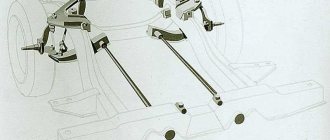Imagine how many fewer accidents there would be if cars could stop instantly. Unfortunately, the elementary laws of physics say that this is impossible.
It is customary for car manufacturers to “boast” about another indicator: acceleration speed up to 100 km/h. Of course, this is also important. But it would be nice to know how many meters the braking distance will stretch. After all, it differs from car to car.
In this article we will talk about what every driver needs to know about braking distances in order to protect themselves on the road. Buckle up and let's go!
What is the braking distance of a car?
The braking distance is the distance that the car will travel after activating the brake system until it comes to a complete stop. This is only a technical parameter by which, in combination with other factors, the safety of the car is determined. This parameter does not include the driver's reaction speed.
The combination of the driver’s reaction to an emergency situation and the distance from the start of braking (the driver pressed the pedal) to the complete stop of the vehicle is called the stopping distance.
The traffic rules indicate critical parameters under which the operation of a vehicle is prohibited. The maximum limits are:
| Transport type: | Braking distance, m. |
| Motorcycle/moped | 7,5 |
| A car | 14,7 |
| Bus/truck weighing up to 12 tons | 18,3 |
| Truck weighing more than 12 tons | 19,5 |
Since the braking distance directly depends on the speed of the vehicle, the critical indicator is the distance covered by the vehicle mentioned above when the speed decreases from 30 km/h. (for motor vehicles) and 40 km/h. (for cars and buses) to zero.
A braking system that responds too slowly will always result in damage to the vehicle and often injury to those in it. For clarity: a car moving at a speed of 35 km/h will collide with an obstacle with a force identical to the impact of a fall from a five-meter height. If the speed of the car in a collision with an obstacle reaches 55 km/h, then the impact force will be identical to that of a fall from the third floor (90 km/h – a fall from the 9th floor, or from a height of 30 meters).
These research results show how important it is for a motorist to monitor the condition of the car’s braking system, as well as tire wear.
Driver reaction time
It is believed that the average driver's reaction time is in the range of 0.5 to 1.5 seconds. This time increases if the driver is intoxicated, tired or ill, distracted from driving, talking on a mobile phone, etc.
Along with a slower reaction, the stopping distance increases and the risk of an accident increases.
Thus, slowing down the driver's reaction by 1 second will lead to the fact that a car moving at a speed of 90 km/h, when danger arises, will travel an extra 25 meters before the driver presses the brake pedal.
Subsequently, these meters may not be enough to prevent accidents.
Driver fatigue is a particular danger. It comes on unnoticed and often ends with the driver falling asleep at the wheel. On long trips, at the first sign of drowsiness, you need to stop and find an opportunity to sleep for at least 30-40 minutes.
What is the braking distance formula?
There are special formulas that help the driver calculate the braking distance during emergency and normal braking. Of course, they are averages.
So, normal braking involves gently pressing the brake pedal, for example at a traffic light. In this case, we are guided by the formula:
(Speed in km/h: 10) * (speed in km/h: 10) = braking distance in meters
That is, if you are moving at a speed of 50 km/h, the braking distance will be approximately 25 meters. We count like this: 50/10 * 50/10 = 5*5 = 25.
During emergency braking, the resulting value is divided by two more. The formula looks like this.
(Speed, in km/h: 10) * (speed, in km/h: 10) / 2
Let's do the math using a specific example. Let's say you are again moving at a speed of 50 km/h and a situation occurs in which you urgently need to brake. We calculate the braking distance as follows: 50/10 * 50/10 / 2 = 5 * 5/2 = 12.5 meters.
You may say that in an emergency there is no time to count and you need to act. Yes, you are absolutely right. But there is one “but”. Each driver moves around the city at approximately the same speed. Therefore, you can learn the desired value in advance and build on it when needed. This simple life hack could one day save someone's life. So take note of it.
What advantages does using winter tires give you in the cold season?
| 1. | The possibility of skidding is eliminated. |
| 2. | It becomes possible to move at the maximum permissible speed in any weather conditions. |
| 3. | The possibility of wheels slipping and slipping on slippery surfaces is reduced. |
Winter tires differ from summer or all-season tires in their special tread pattern and increased traction, which reduces the possibility of wheel slipping or slipping on slippery surfaces. If the car is used on winter roads with snow or icy conditions, it is recommended to use studded tires
However, the use of winter tires, including studded ones, requires drivers to be careful when choosing driving speed, since the possibility of skidding on slippery surfaces cannot be ruled out.
How to calculate the total stopping time and the final braking distance?
As we noted above, the driver needs time to make a decision to brake. That is, to react. Plus, it takes time to move your foot from the gas pedal to the brake pedal and for the car itself to react to this action.
There is a formula that averages out the driver's reaction path. Here she is:
(Speed in km/h: 10) * 3 = reaction distance in meters
Let's imagine the same situation. You are driving at a speed of 50 km/h and decide to brake smoothly. While you are making a decision, the car will travel 50/10*3 = 15 meters. We calculated the second value (the length of the actual braking distance) to be higher - 25 meters. As a result, 15+25 = 40. This is the distance your car will travel until you come to a complete stop.











